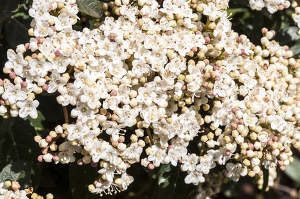

Laurestine is a very beautiful shrub, the appeal of its flowers on par with that of its leaves.
A List of Laurestine facts
Name – Viburnum tinus
Family – Adoxaceae (formerly Caprifoliaceae)
Type – shrub, bay
Height – 6 to 10 feet (2 to 3 meters)
Exposure – full sun to shade
Soil – rich enough
Foliage – evergreen
Flowering – November to March
Planting, pruning and care enhance growth and blooming.
Laurestine is extremely adaptable to most types of soil and locations.
You may plant it indifferently either in spring or fall.
Propagating laurestine
Making cuttings is the easiest and fastest method to propagate your laurestine.
It is also possible to propagate laurestine through layering.
Laurestine is an easy shrub to care for, especially when well settled in.
Pruning laurestine
The pruning of laurestine isn’t mandatory because you can let it grow as it wishes. However, it can be useful when planted as part of a hedge, in a pot, or when you wish to reduce its stature.
Watering Laurestine
The 1st year after planting is when the laurestine most needs water, so the watering needs to be more regular.
Once well settled in, it doesn’t require any dedicated watering.
For laurestine in pots or garden boxes, watering is needed as soon as the surface soil is dry.
Laurestine diseases
Virtually invulnerable to most parasites and diseases, laurestine is particularly hardy.

Its small white flowers will shine light on your garden all through this cold season.
The flowers turn whiter as they age, while magnificent dark pink berries appear to decorate the evergreen leafage in fall.
Easy to care for, it adapts equally well to growing in a flower bed or in a pot on a terrace or balcony.
Hardy to the cold and freezing, it can cope with temperatures dropping down to 5°F (-15°C).
Unlike other laurel shrubs, neither its berries nor its leaves are harvested, since they are inedible and can even be poisonous. Let the birds pick on them at will, they will love it!
If you live in an area where the climate is very harsh in winter, choose a very sunny spot sheltered from wind.